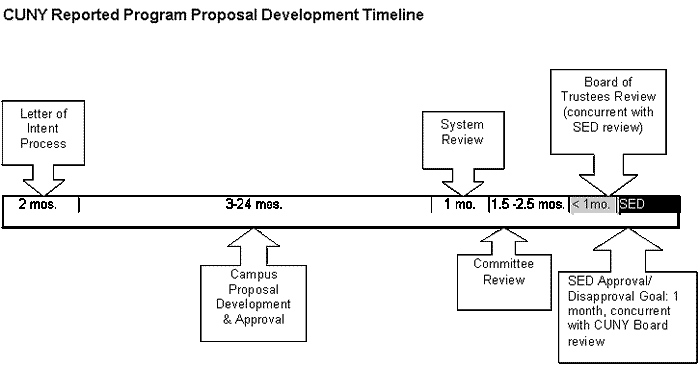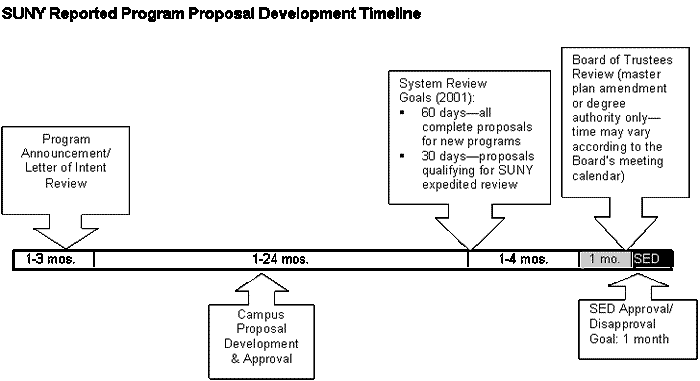Meeting of the Board of Regents | June 2008
|
|
THE STATE EDUCATION DEPARTMENT / THE UNIVERSITY OF THE STATE OF NEW YORK / ALBANY, NY 12234 |
|
TO: |
Higher Education Committee |
|
FROM: |
Johanna Duncan-Poitier
|
|
SUBJECT: |
Mechanisms for Expedited Review of Proposals for Credit-Bearing Programs from Higher Education Institutions |
|
DATE: |
June 4, 2008 |
|
STRATEGIC GOAL: |
Goals 2, 4, and 5 |
|
AUTHORIZATION(S): |
|
SUMMARY
Issue for Discussion
In response to a recommendation in the preliminary report of the New York State Commission on Higher Education, what mechanisms should be developed to expedite the review of proposals for credit-bearing programs submitted by higher education institutions?
Reason(s) for Consideration
For information.
Proposed Handling
This question will come before the Higher Education Committee at its June 2008 meeting for discussion.
Procedural History
Executive Order Number 14 established the New York State Commission on Higher Education on May 29, 2007, and the Commission was charged to broadly examine long-term policy issues facing higher education in the State. In its preliminary report dated December 2007, the Commission recommended that the Board of Regents develop mechanisms to expedite the review of higher education program proposals.
Background Information
Community college presidents reported to the New York State Commission on Higher Education that local governance and The City University of New York (CUNY) and State University of New York (SUNY) system elements account for much of the time frame for the review and approval of CUNY and SUNY proposals for new programs. The Commission recommended that “the Board of Regents review the process for program review to develop mechanisms for expedited review. SUNY and CUNY should coordinate with the Board of Regents to ensure that their internal processes for program review are conducted simultaneously and collaboratively with those of the Regents. This review should be completed by June 2008.”
In the Commission’s view, current time frames for the review of proposed programs—from the time proposals are initiated at the campus level to the State Education Department’s (SED) role at the culmination of the process—mean that “New York’s public institutions are left behind in advancing new ideas and programs” in a climate of global competition. Proposal development and review time frames can be affected by everything from structural factors—e.g., programs that trigger a master plan amendment require additional review steps—to a proposal’s complexity or completeness.
Within CUNY, proposal preparation (to the point of submission to SED, following campus preparation and System review) may range from a minimum of about 7 months to a maximum of 30 months. SUNY reported a range of 3 to 32 months, prior to submission to SED. SED—the Office of College and University Evaluation and the Office of Professional Education Program Review—has a goal of approving or disapproving proposals within 30 days. In 2007, it met that goal close to 70 percent of the time for CUNY and SUNY proposals.
In response to the Commission’s recommendation, representatives from CUNY and SUNY system administrations and SED’s program review offices met several times over the course of four months to consider the proposal review process and related program registration materials. They focused on identifying ways to streamline the process and make it transparent to all involved. In addition to separate meetings between SUNY and SED staff and CUNY and SED staff, representatives of all three organizations met as a group for the first time in recent history to consider mechanisms for ongoing collaboration.
This review did not encompass non-credit programs and courses. Since public and independent institutions may offer non-credit training programs without approval by the Board of Regents or registration by SED, they may develop training in emerging fields without SED involvement.
The CUNY/SUNY/SED collaboration identified five potential mechanisms to leverage improvement:
- Regulation review
- Program registration application materials
- Collaborative review
- Tracking of program proposals
- Communication between SED and the SUNY and CUNY systems
These mechanisms are described in the attached report. The Department also sent a summary of the collaboration and its outcomes to the Commission for inclusion in the Commission’s final report (due by June 2008). Most immediately, the organizations will focus on realizing the mechanisms they identified to expedite the review of program proposals. This includes work both between and within CUNY/SUNY and the Department. Longer term, the organizations agreed on an annual assessment of project progress and outcomes. Opportunities to impact the time frames of the program proposal process exist in all stages of the process, from on-campus program proposal development to SED review.
In addition to continuing its collaboration with CUNY and SUNY, SED will extend its effort beyond the realm of the public institutions to identify mechanisms (such as revised program registration materials) that can benefit all higher education sectors. SED will also examine its strategies and priorities to better support its goal to approve or disapprove all program proposals within 30 days. In this way, SED will support institutional growth and agility in responding to traditional and developing needs in a global environment. CUNY and SUNY systems will continue their collaborative work with SED and review and adjust internal system procedures, over which they have authority.
Recommendation
It is recommended that the Board of Regents and the Department continue to review regulation, rule, policy, and procedure to support a flexible, high-quality system of higher education.
Attachment
State Education Department (SED)/The City University of New York (CUNY)/ State University of New York (SUNY) Collaboration on Expedited Program Review
Background Information
The New York State Commission on Higher Education, in its December 2007 preliminary report, recommended that the Board of Regents “review the process for program review … by June 2008.” The Commission heard from the State’s community college presidents that approval of proposed academic programs involves “multi-layer procedures that can take as long as two years. Local governance and system review processes consume much of the time required for approval.” In its December 2007 preliminary report, the Commission made the following recommendation:
The Commission recommends that the Board of Regents review the process for program review to develop mechanisms for expedited review. SUNY and CUNY should coordinate with the Board of Regents to ensure that their internal processes for program review are conducted simultaneously and collaboratively with those of the Regents…
In the Commission’s view, current proposal review time frames—from the time new program plans are initiated at the campus level to SED’s role at the end of the process—mean that “New York’s public institutions are left behind in advancing new ideas and programs” in a climate of global competition.
Current Process
The complete new-program process for CUNY and SUNY institutions includes time invested on campus and within the systems. Proposal development and review time frames can be affected by everything from structural factors—e.g., programs that trigger a master plan amendment require additional review steps—to a proposal’s complexity or completeness.


![]()
![]()
![]()
![]()
![]()
![]()
![]()
![]()
![]()
![]()
![]()
![]()
![]()
As shown on the timelines, proposal preparation within CUNY (to the point of submission to SED) can range from a minimum of about 7 months to a maximum of 30 months. SUNY reported a range of 3 to 32 months, prior to submission to SED.
In 2006 SED (the Office of College and University Evaluation and the Office of Professional Education Program Review) received 1,584 program proposals; 33 percent of those were from CUNY and SUNY. In 2007, 41 percent of the 1,679 proposals were from those systems. Recent time frames for the culminating, SED phase of the program proposal process are summarized in the following chart.
|
SED Review Time |
CUNY Proposals |
SUNY Proposals |
||
|
2006 |
2007 |
2006 |
2007 |
|
|
Within 30 days |
62% (65) |
69% (150) |
57% (240) |
67% (319) |
|
31-60 days |
13% (14) |
14% (30) |
23% (95) |
18% (86) |
|
61-90 days |
13% (13) |
11% (24) |
10% (43) |
7% (33) |
|
Over 90 days |
12% (12) |
6% (14) |
10% (41) |
8% (36) |
|
Total Registered |
104 |
218 |
419 |
474 |
Department Collaboration with SUNY and CUNY
In response to the Commission’s recommendation, representatives from CUNY and SUNY system administrations and SED’s program review offices met several times over the course of four months to consider the proposal review process and related program registration materials. They focused on identifying ways to streamline the process and make it transparent to all involved. In addition to separate meetings between SUNY and SED staff and CUNY and SED staff, representatives of all three organizations met as a group for the first time in recent history to consider mechanisms for ongoing collaboration.
Note: public and independent colleges and universities may offer non-credit programs without approval by the Board of Regents or registration by SED. This offers institutions the ability to develop training in emerging fields without SED involvement. As a result, the process review described in this report did not encompass non-credit programs and courses.
Proposed Mechanisms to Expedite Proposal Review
The CUNY/SUNY/SED collaboration yielded five general mechanisms for improvement, including several elements related to program registration materials.
1) Regulation Review
Discussions among CUNY, SUNY, and SED staff clarified existing requirements and revisited the basis for their existence. Since core requirements and related processes are dependent on or are consistent with the Regulations of the Commissioner of Education, SED and the higher education sectors will review the Regulations to determine if there are any elements that may no longer add value or contribute to the Department’s quality assurance and consumer protection functions. For example, SUNY has proposed regulatory relief to allow a program registered at one campus to be offered at another SUNY campus. Under current Regulations, such a program would need a separate SED review and registration for the other campus (including master plan amendment, if necessary).
Systematic review of Commissioner’s Regulations will contribute to fulfilling the Regents initiative in support of the Statewide Plan for Higher Education’s Priority E12 (Encouraging a Highly Effective System) to “review Commissioner’s Regulations…in collaboration with the sectors to identify requirements that may no longer be necessary.”
2) Program Registration Application Materials
Work group feedback on the program registration application focused on revising SED’s materials to help campus and System representatives better understand SED expectations. The elements defined (as listed in the attached summary chart) relate to both the program registration materials in general and the specific elements on which institutions are asked to provide information.
Next steps range from clarifying the wording in the program registration materials to more complex initiatives that will entail continuing collaboration between SED and CUNY and SUNY representatives. For example, a team will be charged to establish a common understanding of “liberal arts and sciences,” while other work will focus on enhancing the SED Web site and establishing master files of institutional information that may not vary from program to program (e.g., institutional mission and evaluation). In addition, SUNY and CUNY representatives will coordinate further with SED to align their program registration materials with the Department’s revised materials.
3) Collaborative Review
The Commission’s recommendation included the possibility of simultaneous as well as collaborative CUNY/SUNY and SED proposal reviews. To reduce unnecessary redundancy, CUNY/SUNY and SED representatives agreed to identify proposal elements that could be evaluated exclusively by CUNY/SUNY or SED staff. Coordinated activities may also include early-stage collaboration to refine proposals that are particularly complex (e.g., curricula that serve both general degree and professional licensure purposes), raise novel issues, or are incomplete.
One process enhancement is under way. Under the pilot effort, CUNY administration is submitting its program proposals simultaneously to both its Board of Trustees and to SED after approval by the CUNY Board’s Committee on Academic Policy, Programs and Research (CAPPR). This allows SED staff members to begin their review during the time frame between CAPPR’s recommendation and Board of Trustees consideration—or three-to-four weeks earlier, on average.
4) Tracking of Program Proposals
As with most of the other improvement areas, this mechanism is grounded in the idea that clear and ongoing communications between CUNY, SUNY, and SED will yield efficiencies. Proposal tracking in this context includes establishing shared proposal tracking reports, periodic problem-solving sessions, and a mechanism to follow up on incomplete proposals.
5) Communication Between the Systems and the Department
This last improvement category addresses “communications” in its most literal form: mechanisms and protocols governing who talks to whom and when, to support a transparent and efficient proposal review process. This area includes such elements as contact protocols (e.g., guidance about SED contacts with campus representatives), the sharing of institutional assignment lists, and regular meetings between CUNY, SUNY, and SED staff. In addition, CUNY and SUNY administrators and SED representatives discussed the possibility of regional workshops with campus representatives to enhance understanding of the proposal process.
Future Consideration
The work groups identified an array of potential areas of improvement, but in the interest of focusing effort some ideas have been set aside because of the density of resources they would require. These ideas include (among others) establishing a joint, Web-based system for the submission and review of proposals; a review of the Governor’s statutory role in the CUNY and SUNY master planning process; and enhancements to the online Inventory of Registered Programs.
Next Steps
Most immediately, the three organizations will focus on the strategies identified to expedite proposal review. This includes work both between and within CUNY/SUNY and SED. Longer term, the organizations agreed on a mutual, annual assessment of progress and outcomes. In addition to collaborative work with SED, CUNY and SUNY have identified in-system steps to streamline their respective processes. Examples of next steps include the following:
- SUNY will update its proposal guidelines to clarify process and content, in alignment with SED’s efforts in those areas.
- SUNY will further enhance transparency of its review process, including online access to the status of program proposals undergoing review.
- In addition to continuing its pilot proposal-submission process, CUNY has updated its Faculty Handbook for the Preparation of New Programs and will prepare a special supplement dedicated to teacher education proposals.
- Starting in fall 2008, CUNY will offer faculty and staff workshops and Web-based materials on preparing program proposals and curricular changes.
Next steps for SED include efforts to expand its work beyond the public systems to identify mechanisms (such as revised program registration materials) to benefit all higher education sectors. SED will also examine its strategies and priorities to better support its goal to approve or disapprove program proposals within 30 days. This effort will help SED better support institutional growth and agility in responding to traditional and developing needs. Such agility is critical in an environment in which higher education institutions are simultaneously both in demand and in competition.
Summary: Expedited Review of CUNY/SUNY Programs
|
Mechanisms for Improvement |
Deliverables |
Purpose |
Timeline |
|---|---|---|---|
|
Regulation Review |
Revised Commissioner's Regulations relating to program registration |
Ensure provisions in Commissioner’s Regulations add value to the State's quality assurance and consumer protection functions |
December 2009 |
|
|
|||
|
Program Registration Elements
|
Revised program registration materials that provide clear direction about State Education Department requirements and expectations |
Enable a transparent program review process that supports the submission of complete and well-informed general, professional licensure, and teacher education proposals |
September 2008 |
|
Collaborative Review |
Mechanisms to coordinate review of program proposals |
Reduce cycle time by limiting duplicative review elements, collaborating upfront on programs that are complex/innovative, and reducing or eliminating investment in incomplete or underdeveloped program proposals |
August 2008 |
|
Proposal Tracking |
Mechanisms to share proposal tracking reports and to follow up on incomplete proposals and programs registered with conditions |
Ensure efficient processing and effective oversight by supporting coordinated program review and follow up |
July 2008 |
|
Communication Between SED & Systems |
Mechanisms to facilitate general communication between SED, systems, and campuses |
Drive a transparent and coordinated program review process by clarifying and reinforcing working relationships |
July 2008 |
December 2007 preliminary report
Excluding proposed licensure-qualifying programs and proposals that do not require charter or master plan action.
New York State Commission on Higher Education, A Preliminary Report of Findings and Recommendations, December 2007, page 24.
Excluding proposed licensure-qualifying programs and proposals that do not require charter or master plan action.





